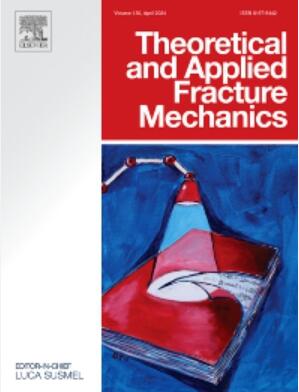Defect features critical to the fatigue of additively manufactured Ti-6Al-4V
IF 5
2区 工程技术
Q1 ENGINEERING, MECHANICAL
引用次数: 0
Abstract
This study aimed to identify the morphological features of process-induced volumetric defects most influential on the fatigue behavior of laser powder bed fused Ti-6Al-4V. Fatigue test specimens were machined from round bars fabricated using eight distinct process parameter sets and three build orientations to ensure a wide range of defect morphologies and populations. Uniaxial, constant amplitude, fully-reversed fatigue tests were conducted on these specimens until failure. Fractography was performed to identify the defect responsible for the fatigue crack initiation and extract its morphological features. The influence of these features on fatigue behavior was examined by analyzing experimental data and finite element analysis results. While size was the most critical defect feature influencing fatigue behavior, it could not fully explain the variation in fatigue life by itself. For defects of similar size located at the same location, circular defects appeared to be more detrimental than irregularly shaped ones. A new defect size parameter, the square root area of the maximum inscribed circle, was introduced to partially account for both the size and shape of the volumetric defects, which exhibited a strong correlation with life compared to existing parameters.

增材制造Ti-6Al-4V疲劳的关键缺陷特征
本研究旨在确定对激光粉末床熔接Ti-6Al-4V疲劳行为影响最大的工艺诱导体积缺陷的形态特征。采用八种不同的工艺参数集和三种构建方向加工圆形棒,以确保广泛的缺陷形态和种群。对这些试件进行单轴、恒幅、全反向疲劳试验,直至失效。采用断口学方法识别导致疲劳裂纹萌生的缺陷并提取其形貌特征。通过对试验数据和有限元分析结果的分析,考察了这些特征对疲劳行为的影响。尺寸是影响疲劳行为最关键的缺陷特征,但尺寸本身并不能完全解释疲劳寿命的变化。对于相同位置的相似尺寸缺陷,圆形缺陷比不规则形状缺陷更有害。引入了一个新的缺陷尺寸参数,即最大内切圆面积的平方根,可以部分地解释体积缺陷的尺寸和形状,与现有参数相比,该参数与寿命具有很强的相关性。
本文章由计算机程序翻译,如有差异,请以英文原文为准。
求助全文
约1分钟内获得全文
求助全文
来源期刊

Theoretical and Applied Fracture Mechanics
工程技术-工程:机械
CiteScore
8.40
自引率
18.90%
发文量
435
审稿时长
37 days
期刊介绍:
Theoretical and Applied Fracture Mechanics'' aims & scopes have been re-designed to cover both the theoretical, applied, and numerical aspects associated with those cracking related phenomena taking place, at a micro-, meso-, and macroscopic level, in materials/components/structures of any kind.
The journal aims to cover the cracking/mechanical behaviour of materials/components/structures in those situations involving both time-independent and time-dependent system of external forces/moments (such as, for instance, quasi-static, impulsive, impact, blasting, creep, contact, and fatigue loading). Since, under the above circumstances, the mechanical behaviour of cracked materials/components/structures is also affected by the environmental conditions, the journal would consider also those theoretical/experimental research works investigating the effect of external variables such as, for instance, the effect of corrosive environments as well as of high/low-temperature.
 求助内容:
求助内容: 应助结果提醒方式:
应助结果提醒方式:


